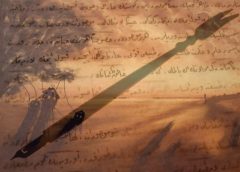
Italian author Umberto Eco who was born in 1932 says in his book The Confessions of a Young Novelist that he had answered the question “How did you write your novels?” as “From left to right” .
Writing from left to right is also the way we are used to and we do not have the necessary means to evaluate its accuracy. And writing from right to left, the way our ancestors wrote Turkish with the letters of Islam for a thousand year is a treasure we forgot or were made forgotten.
Peyami Safa wrote in 1971: “I believe that it is a necessity that we teach our youth Arabic letters in high schools as we already teach in Faculty of Letters not to deprive them of the miraculous, comfort, pace and practical easiness of writing and reading of Arabic letters when writing down something and to give them the opportunity to read the masterpieces and sources of our history and literature.” (Din İnklap İrtica, Ötüken Pub., 1971 İstanbul)
It has been forty years since then. Fortunately, Ottoman Turkish was put in the curriculum of the High schools of Socials Sciences as an elective course. Nowadays, numerous foundations and institutions open Ottoman Turkish courses and there is a considerable demand for them. As our youth realize the treasure, the desirous of “writing from right to left” will increase.
Here is a remarkable anecdote on the subject narrated by Historian of Sciences Fuat Sezgin about his teacher in the interview with Sefer Turan which is currently published into a book: “People who know the Arabic letter and are
able to write Ottoman Turkish comfortably prefer this writing especially while writing down something. Because there is nearly no vowels in this system and the fluent shapes of the letters gives it a character of stenography. Thus the books are written and circulate very fast. For this reason, the teacher of Fuat Sezgin, Ritter regards Arabic as a language consisting 5 speed. He takes a sheet and pen and writes “Ritter” and says this goes with the pace of a donkey and he adds “This is donkey speed.” (Asım Öz, Dünya Bülteni)
I will share three of the answers from a small-scale online survey that I made asking the question “Is it easier to write from left to right or from right to left?”
“As we all learned writing from left to right first we think that it is easier for us. Indeed that was what I thought in the beginning. But later on, as I started to write Ottoman Turkish from right to left I realized that this way is easier. Because, if we observe the arm movement we will see that moving the arm inside-out is harder than outside-in.” (Ercan Köksal)
“Physically, it is easier to pull an object rather than pushing it. Someone writing from left to right applies a pulling force. Someone writing from right to left only applies a soft pushing force. Even though we write with the movements of our hands and arms, we also use our eyes in the process of writing. Because, while our hand is writing, our eyes follow it. The flow from right to left is the healthy one for the eyes. In this way our eyes do not get tired fast. As a result, it is more comfortable to write from right to left as it is in coherence with the body movements. You can understand it by trying it on your body.” (Ahmet Hüsrev Adiloğlu)
“Eye muscles are created to work in a right-to-left direction. Reading from left to right is like walking backwards, so people are easily bored while reading this way.” (Fahrettin Kör)
Even though reading and writing from right to left is ability that we have forgotten for a long time it is not hard to regain it. Even if it seems hard, there hundreds of thousands of documents waiting to be read and discovered. With the words of Sezai Karakoç, “It is high time that we protect “our script” and review our direction settings. It is an obligation and responsibility for us. Language is the expression of our way of life through words. The script binds the generations together and records the language. If the language is the memory of a nation then the script is the source of life and the main constituent of it.”
It is not time to
look at the past but to future with discretion. While looking at the future we need a vision nourishing from the past.
Our grandfathers did not know writing from left to right. And most of us do not know how to write from right to left. It is in our hands making our grandchildren know both ways!

